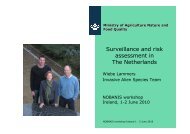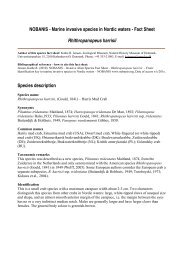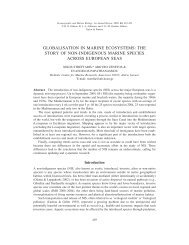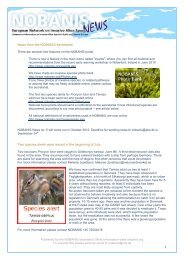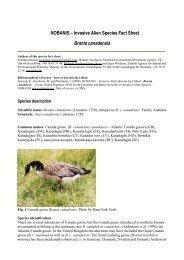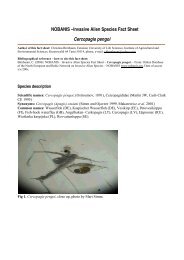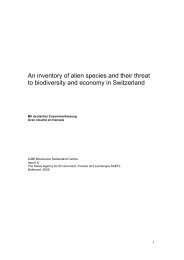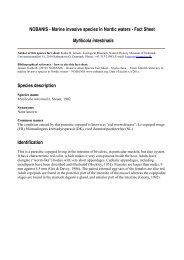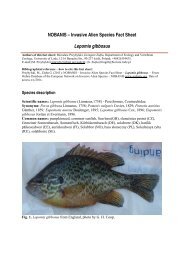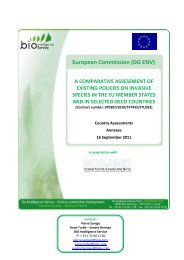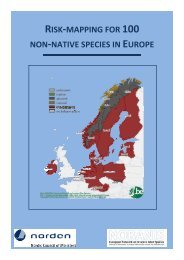Galinsoga quadriradiata - NOBANIS
Galinsoga quadriradiata - NOBANIS
Galinsoga quadriradiata - NOBANIS
You also want an ePaper? Increase the reach of your titles
YUMPU automatically turns print PDFs into web optimized ePapers that Google loves.
<strong>NOBANIS</strong> – Invasive Alien Species Fact Sheet<br />
<strong>Galinsoga</strong> <strong>quadriradiata</strong><br />
Author of this fact sheet: Nora Kabuce, Latvian Environment, Geology and Meteorology Agency, Maskavas Str. 165,<br />
Riga, LV-1019, Latvia. Tel.: +371 7032030; e-mail: nora.kabuce@lvgma.gov.lv and Agnese Priede, Nature<br />
Conservation Agency, Meza maja, Kemeri, Jurmala, LV-2012, Latvia, Phone: +371 29640959, E-mail:<br />
agnese.priede@daba.gov.lv<br />
Bibliographical reference – how to cite this fact sheet:<br />
Kabuce, N. and Priede, N. (2010): <strong>NOBANIS</strong> – Invasive Alien Species Fact Sheet – <strong>Galinsoga</strong> <strong>quadriradiata</strong>. – From:<br />
Online Database of the North European and Baltic Network on Invasive Alien Species – <strong>NOBANIS</strong> www.nobanis.org,<br />
Date of access x/x/201x.<br />
Species description<br />
Scientific names: <strong>Galinsoga</strong> <strong>quadriradiata</strong> Ruiz & Pav., Compositae (Asteraceae)<br />
Synonyms: Wilburgia urticifolia Kunth, Adventina ciliata Raf., <strong>Galinsoga</strong> urticifolia (Kunth)<br />
Benth., G. ciliata (Raf.) S.F. Blake, G. hispida Benth., G. aristulata Bickn., G. bicolorata St.John<br />
& White, G. caracasana (DC.) Schultz-Bip.<br />
In some European floras the synonym G. ciliata (Raf.) S.F. Blake is considered to be a separate<br />
species and G. <strong>quadriradiata</strong> auct. is often cited as a synonym for G. ciliata. However, in its native<br />
range in South and Central America as well as in modern floras in various European countries G.<br />
ciliata (Raf.) S.F. Blake is defined as a synonym for G. <strong>quadriradiata</strong> Ruiz & Pav., and G.<br />
<strong>quadriradiata</strong> clearly has priority. <strong>Galinsoga</strong> as a genus was described by Ruiz and Pavón in 1794,<br />
G. parviflora was described by Cavanilles in 1795, and G. <strong>quadriradiata</strong> was described by Ruiz<br />
and Pavón in 1798. Flora of North America gives 32 synonyms for the species G. <strong>quadriradiata</strong>.<br />
The name ciliata is based on Adventina ciliata, described by Rafinesque in 1836, and even the name<br />
urticifolia will have priority before that name, as Wilburgia urticifolia was described by Kunth in<br />
1818. The recombinations G. ciliata was done by S.F. Blake in 1922 and G. urticifolia by Bentham<br />
in 1852.<br />
Common names: hairy galinsoga/shaggy soldier (GB), behaartes Franzosenkraut (DE), kirtelkortstråle<br />
(DK), karvane võõrkakar (EE), ripsisaurikki (FI), blakstienotoji galinsoga (LT), matainā<br />
sīkgalvīte (LV), harig knopkruid (NL), nesleskjellfrø (NO), żółtlica owłosiona (PL), галинзога<br />
четырехъязычковая (RU), hårgängel (SE), pěťour srstnatý (CZ).<br />
Fig. 1. Stem of <strong>Galinsoga</strong> <strong>quadriradiata</strong>, photo by Normunds Rustanovičs.
Fig. 2. Flowers of <strong>Galinsoga</strong> <strong>quadriradiata</strong>, photo by Normunds Rustanovičs.<br />
Fig. 3. Leaves and flowers of <strong>Galinsoga</strong> <strong>quadriradiata</strong>, photo by Normunds Rustanovičs.<br />
Species identification<br />
<strong>Galinsoga</strong> <strong>quadriradiata</strong> has an erect stem, 10 – 80 cm high with many branches and covered by<br />
coarse hairs. The leaves are opposite, dark green, up to 6 cm long and 4 cm wide, simple, ovate,<br />
acute to acuminate, broadest at the base; the leaf-margin is dentate; both surfaces are bristly hairy<br />
(Fig. 1). Flower heads are less than 1 cm wide and consist of 4 or 5 white, 3-toothed ray florets and<br />
many yellow disk florets (Fig. 2-3). The fruit is an achene, 1.5 mm long, hairy, tapered from the<br />
base to the apex, with a white pappus that resembles a crown. Pappus scales are entire and involved<br />
bracts have a very narrow, acute apex (Anonymous 1996, Šulcs 1998, Reinhardt et al. 2003).<br />
Due to some similarities it is often confused with G. parviflora, which is paler green, has short hairs<br />
and 3–lobed pappus scales and involved bracts with broader and rounded apex (A. Kurtto, pers.<br />
comm.).<br />
2
Native range<br />
The native range of G. <strong>quadriradiata</strong> covers parts of South and Central America from Mexico to<br />
Chile, but due to human activity the species has been spread far from its original range (Fig. 4.).<br />
Fig. 4. Distribution of <strong>Galinsoga</strong> <strong>quadriradiata</strong> (Hultén and Fries 1986).<br />
Alien distribution<br />
History of introduction and geographical spread<br />
<strong>Galinsoga</strong> species originate in South America. Firstly, <strong>Galinsoga</strong> species were introduced from<br />
Peru into Kew Gardens in the U.K. in 1796 and by 1863 G. parviflora was described as ‘quite as<br />
common as groundsel’ in the area between Kew and East Sheen (Gray 1863 in Bond et al. 2006). In<br />
comparison to its congener species G. parviflora, G. <strong>quadriradiata</strong> did not spread that rapidly,<br />
however both of them are similar in their spreading histories. Nowadays G. <strong>quadriradiata</strong> is a weed<br />
growing in many crops, gardens and wastelands in most temperate and subtropical regions of the<br />
world (Kagima 2000). It is one of the most common weeds in North America. The earliest recorded<br />
naturalized population in North America was found in the vicinity of Philadelphia, where it was<br />
growing in the Bartram Botanical Garden from 1836 (Shontz and Shontz 1970 in Kagima 2000).<br />
The species is extensive in Africa (Kagima 2000), present also in India (Gopinathan, Babu 1982),<br />
Nepal (Manandhar 2002), Taiwan and other regions of the world.<br />
In Europe G. <strong>quadriradiata</strong> was first recorded at the end of 19 th century (Šulcs 1998), and currently<br />
it is established in many European countries. In Germany G. <strong>quadriradiata</strong> was first found in<br />
Hamburg in 1892 (Reinhardt et al. 2003) and in 1925 in the Netherlands (Leni Duistermaat,<br />
pers.comm.). In the Baltic States the species was first found in Estonia in 1921 (Tartu) escaped<br />
from the botanical garden, and in Lithuania in 1924 (Gulbinai, environs of Vilnius) (Kuusk et al.<br />
3
2003). In Latvia the first record dates back to 1928 in Liepāja in West Latvia (Melderis 1939). In<br />
the Nordic countries the first observations of G. <strong>quadriradiata</strong> are from Norway in 1900 (Lid and<br />
Lid 2005), in Sweden it was first recorded in 1926 (Almquist 1929 in Hylander 1971), in Denmark<br />
in 1927 (Hansen and Pedersen 1961) and in Finland in 1928 (Saansalo–Taubert 1962). In Poland,<br />
the species was first found in the second half of the 20 th century near Wrocław<br />
(www.iop.krakow.pl/ias/), while the first herbarium records in Poland date back to 1876 (Tokarska-<br />
Guzik 2005). In Russia, it was found in 1842 as escaped from Saint-Petersburg Botanical Garden<br />
(Гусев 1966). Occasionally <strong>Galinsoga</strong> <strong>quadriradiata</strong> has been found in the European part of Russia<br />
since the 1920s. After 1945 it has expanded in the Ukraine and Belarus. The spreading to the northwestern<br />
and central districts of Russia is registered from the 1970s (Виноградова 2003). The first<br />
record from Siberia was registered in 1991 (Зарубин и др. 1993).<br />
Detailed list of the first records and expansion history of G. <strong>quadriradiata</strong> in numerous European<br />
countries is given by Schultz (1984).<br />
The species has still not been found in Iceland, Greenland and the Faroe Islands.<br />
Pathways of introduction<br />
Since 1849, <strong>Galinsoga</strong> <strong>quadriradiata</strong> was grown in the European botanical gardens and most<br />
probably the species has escaped from there, similarly as its congener species G. parviflora.<br />
Additionally, in many European countries G. <strong>quadriradiata</strong> is introduced unintentionally -<br />
transported with soil, with grain or other agricultural products or the seeds have arrived attached to<br />
transport vehicles. For instance in Denmark it is hypothesised that the species has had two main<br />
routes of unintentional introduction, the first one being with commodities to harbour areas and the<br />
other as a pollution in seeds purchased for gardening (Hansen and Pedersen 1962). In Germany, G.<br />
<strong>quadriradiata</strong> was first found in a coffee midden suggesting that the species was unintentionally<br />
imported with coffee-beans (Reinhardt et al. 2003). In Finland, it appears that the species has been<br />
introduced exclusively with imported seeds and seedlings of ornamental plants, first to commercial<br />
greenhouses and nurseries and then to private gardens and public plantations (A. Kurtto, pers.<br />
comm.).<br />
Alien status in region<br />
The species is naturalised in many European countries (Table 1). In Germany and Poland it has<br />
spread throughout the entire territories and is especially common in areas under cultivation as well<br />
as on ruderal sites (Reinhardt et al. 2003, Tokarska-Guzik 2003) (Fig. 5).<br />
In the Baltic States the species is common weedy plant throughout the entire territory occurring in<br />
crops and on arable lands (Gudžinskas 1997, Kuusk et. al. 2003). In Latvia and Lithuania G.<br />
<strong>quadriradiata</strong> is an unintentionally introduced species and has never been grown in botanical<br />
gardens. The most intensive spreading of G. <strong>quadriradiata</strong> in Lithuania was noted in the 1980s<br />
(Gudžinskas 1997). In recent years it has spread very quickly throughout Latvia, and currently in<br />
some places it appears more common and successful invader than G. parviflora, the previously<br />
prevailing <strong>Galinsoga</strong> species in Latvia. The frequency of both species might be changed or due to<br />
the similarity of both species and lack of special interest on these invaders they have been confused<br />
in the literature (M. Ausmane, pers. comm.). In Estonia it has invaded natural plant communities,<br />
but occurs mostly in the southern parts of the country. It grows as a weed in fields and gardens,<br />
railways, coastland and dumpsites (Kull and Kukk 2005).<br />
4
Fig. 5. Distribution of <strong>Galinsoga</strong> <strong>quadriradiata</strong> in Germany (www.floraweb.de)<br />
The species is common in Denmark, but is not considered as invasive (Hansen and Pedersen 1962,<br />
Mossberg and Stenberg 1999). In Finland G. <strong>quadriradiata</strong> is a fairly common weed of heated<br />
greenhouses, while in open areas it is rare and has established only in a few cities in the southern<br />
part of the country. Due to its low frequency and prevalence for human-created habitats, the species<br />
cannot be regarded as invasive in Finland (A. Kurtto, pers. comm.). In Norway the species has a<br />
weedy character occurring in urban areas and ruderal sites. It is fairly common in the surroundings<br />
of Oslo, and it has some scattered localities along the southern coast to about Stavanger in the<br />
south-west. It is still considered to be expanding its range in Norway (Lid and Lid 2005).<br />
In Russia G. <strong>quadriradiata</strong> is naturalised in the southern part of the European Russia, and it is<br />
considered as rare and not established in the northern districts (Цвелев 2000, Григорьевская и др.<br />
2004).<br />
5
Country<br />
Austria<br />
Belgium<br />
Czech republic<br />
Denmark<br />
Estonia<br />
European part of Russia<br />
Finland<br />
Faroe Islands<br />
Germany<br />
Greenland<br />
Iceland<br />
Ireland<br />
Latvia<br />
Lithuania<br />
Netherlands<br />
Norway<br />
Poland<br />
Slovakia<br />
Sweden<br />
Not<br />
found<br />
X<br />
X<br />
X<br />
Not<br />
established<br />
X<br />
Rare Local Common Very<br />
common<br />
X<br />
X<br />
X<br />
X<br />
X<br />
X<br />
X<br />
X<br />
X<br />
X<br />
X<br />
X<br />
X<br />
X<br />
Not<br />
known<br />
Table 1. The frequency and establishment of <strong>Galinsoga</strong> <strong>quadriradiata</strong>, please refer also to the<br />
information provided for this species at www.nobanis.org/search.asp. Legend for this table: Not<br />
found – The species is not found in the country; Not established - The species has not formed selfreproducing<br />
populations (but is found as a casual or incidental species); Rare - Few sites where it is<br />
found in the country; Local - Locally abundant, many individuals in some areas of the country;<br />
Common - Many sites in the country; Very common - Many sites and many individuals; Not<br />
known – No information was available.<br />
Ecology<br />
Habitat description<br />
<strong>Galinsoga</strong> <strong>quadriradiata</strong> is adapted to a warm climate and heavy, nitrogen-rich and clayey soils<br />
(Anonymous 1996). It is found in gardens, greenhouses, plantations, cultivated plots, roadsides,<br />
railways and dump sites, especially in urban areas (Gudžinskas 1997, Šulcs 1998, Reinhardt et al.<br />
2003). These habitats are very similar to habitats where G. <strong>quadriradiata</strong> is found in its native<br />
range, where it is also a common weed. Penetration of G. <strong>quadriradiata</strong> into riverbank communities<br />
and habitats is noted in Lithuania (Gudžinskas 1997).<br />
In Poland, it is a common crop weed and ruderal plant, found in plant communities of Sisymbrion,<br />
Eu-Polygonion and Panico-Setarion alliances. More rarely it occurs in semi-natural habitats such as<br />
forest paths, clearings and margins in mixed coniferous and deciduous woodlands (Chmura 2004,<br />
Tokarska-Guzik 2005).<br />
Reproduction and life cycle<br />
G. <strong>quadriradiata</strong> is an annual plant and propagation is only by seeds. G. <strong>quadriradiata</strong> flowers<br />
from June until late autumn. The plant is either self- or insect-pollinated (Reinhardt et al. 2003).<br />
6
Seeds are enclosed in an achene and are small, about 1.5 mm long. A plant 8-9 weeks old can<br />
produce 3000 flower heads and a large number of seeds, up to 7500 (Kagima 2000, Huffman 2004).<br />
Seeds are able to germinate immediately upon contact with warm moist soil; therefore the plant can<br />
achieve 2-3 generations each growing season (Reinhardt et al. 2003). However, the species is very<br />
sensitive to frost, and its seeds require high temperatures to germinate (A. Kurtto, pers. comm.).<br />
<strong>Galinsoga</strong> seeds are viable for only a few years under field conditions (Huffman 2004).<br />
Dispersal and spread<br />
Seed dispersal is by wind or animal transport (Reinhardt et al. 2003), sometimes by water (Melderis<br />
1939). The small, light seeds can be blown for short distances by the wind. The achenes are covered<br />
with short stiff hairs, which may help them cling to the fur of animals or the clothing of humans<br />
(Shontz and Shontz 1970 in Kagima 2000). Furthermore, dispersal by human activities related to<br />
gardening such as transport of soil and plants plays a major role in the dispersal of the species<br />
(Hansen and Pedersen 1961).<br />
At least in Finland, the most effective vectors of dispersal are from clumps of seedlings raised in<br />
municipal nurseries or bought in commercial greenhouses. The species is also spread with transport<br />
of garden soil (A. Kurtto, pers. comm.).<br />
Impact<br />
Affected habitats and indigenous organisms<br />
G. <strong>quadriradiata</strong> is often found on arable lands and in gardens. It is highly competitive and spreads<br />
quickly often being the dominant species in a field. However, since the species is rarely and<br />
occasionally found in natural or semi-natural habitats, its impact on native natural habitats and<br />
native species is negligible. No negative effects on habitats or indigenous organisms are known.<br />
Genetic effects<br />
G. <strong>quadriradiata</strong> can hybridise with G. parviflora (Gopinathan and Babu 1982; Reinhardt et al.<br />
2003).<br />
Human health effects<br />
No effects on human health are known<br />
Economic and societal effects (positive/negative)<br />
G. <strong>quadriradiata</strong> causes economical damage to the crop cultures as a strong competitor in weedy<br />
plant communities. G. <strong>quadriradiata</strong> is a permanent problem for many farmers including<br />
commercial greenhouses, but there are no data on the cost of controlling it as an agricultural weed.<br />
The presence of G. <strong>quadriradiata</strong> may reduce yields up to 10 - 50 % in fields planted with<br />
vegetables and crops (Kuniga 1994). G. <strong>quadriradiata</strong> takes up nutrients that are necessary for the<br />
growth of cultivated plants. Other damage is caused by the relatively high leaf surface area of G.<br />
<strong>quadriradiata</strong>, which may shade out cultivated plants (Reinhardt et al. 2003).<br />
<strong>Galinsoga</strong> species serve as alternate hosts for many insects, viruses and nematodes which affect<br />
crop species (Huffman 2004).<br />
The young stems and leaves of <strong>Galinsoga</strong> species are cooked and eaten as a vegetable in Africa and<br />
southeast Asia. In South America its dried leaves are used as an essential flavouring for certain<br />
dishes (Kagima 2000, Grubben and Denton 2004).<br />
7
Management approaches<br />
Prevention methods<br />
In its introduced range, <strong>Galinsoga</strong> species are considered rather a noxious weed and thus<br />
problematic for farming than a problem for native habitats or species. Therefore the prevention<br />
methods are adjusted to the needs of farming in order to prevent establishment and spread of the<br />
unwanted weed and host for agricultural pest. In Europe, the species is not listed in black lists of<br />
invasive plants.<br />
Eradication, control and monitoring efforts<br />
<strong>Galinsoga</strong> species are best controlled during early blooming period in order to prevent seed<br />
production. There are several herbicides which are very effective in controlling G. <strong>quadriradiata</strong><br />
(Reinhardt et al. 2003), but since it mainly occurs as a weed in fields planted with vegetables and<br />
intercrops, herbicide use is limited or impossible. Priority has been given to biological methods<br />
used in weed control (Turakainena 2001). Crop rotation is encouraged, for example, a rotation with<br />
corn and tomatoes is recommended (Kagima 2000). Summer cover crops of Sorghum bicolor or<br />
Sorghum sudanense will suppress the germination of G. <strong>quadriradiata</strong> seeds. Early tillage to bury<br />
seeds may be useful, since <strong>Galinsoga</strong> seeds germinate best in lightly disturbed soil not deeper than<br />
2 to 3 cm (Huffman 2004). Black plastic mulch is a good control in intensive agriculture production<br />
or in home horticulture. One of the other possible control measures is the use of allelopathy.<br />
Allelopathy traits in winter rye have been reported (Turakainena 2001). If <strong>Galinsoga</strong> has recently<br />
appeared in the garden, regular combating with a hoe is likely to be successful.<br />
Information and awareness<br />
The information (articles in press, other media etc.) on <strong>Galinsoga</strong> species spread for public is<br />
mainly related to control and eradication methods for gardeners and farmers, e.g. Bond et al. (2006).<br />
No campaigns concerning particularly G. <strong>quadriradiata</strong> are known in the region. In some cases,<br />
some attention was paid in a context to other alien plants, e.g. in Estonia the Ministry of<br />
Environment has published two booklets giving information on invasive alien species of local<br />
importance (in 2001 and 2005), which also mention this species.<br />
Knowledge and research<br />
Research on the effect of winter rye and winter rape in <strong>Galinsoga</strong> seed viability and development<br />
was conducted in 2001 in the Latvian University of Agriculture, Department of Soil Management<br />
(M. Ausmane, pers. comm.).<br />
Recommendations or comments from experts and local communities<br />
None.<br />
References and other resources<br />
Contact persons<br />
Franz Essl (AT), Umweltbundesamt, Naturschutz, Spittelauer Lände 5, 1090 Wien, Austria<br />
Phone: +43- (0) 1-313 04/3323, Fax: +43- (0) 1-313 04/3700, E-mail:<br />
franz.essl@umweltbundesamt.at<br />
Filip Verloove (BE), E-mail: filip.verloove@cepa.be<br />
8
Bohumil Mandák (CZ), Institute of Botany, Academy of Sciences of the Czech Republic, CZ-252<br />
43 Průhonice, Czech Republic, e-mail: mandak@ibot.cas.cz<br />
Frank Klingenstein (DE), Federal Agency for Nature Conservation, Konstantinstr. 110, DE-53179<br />
Bonn, Germany, Phone: +49(0)228/8491-264, E-mail: frank.klingenstein@bfn.de<br />
Henrik Ærenlund (DK), Botanical Garden and Museum, Natural History Museum, Gothersgade<br />
130, DL-1123 Copenhagen K, Denmark, Phone: +45 3532 2190, E-mail: henrikp@snm.ku.dk<br />
Christina Birnbaum (EE), Estonian University of Life Sciences, Institute of Agricultural and<br />
Environmental Sciences, Kreutzwaldi 64, EE-51014 Tartu, Estonia, E-mail:<br />
chbirnbaum@yahoo.com<br />
Arto Kurtto (FI), Finnish Museum of Natural History, Botanical Museum, P.O. Box 7, University of<br />
Helsinki, FI-00014, Helsinki, Finland, Phone: +358-9-191 8630, E-mail: arto.kurtto@helsinki.fi<br />
Colette O'Flynn (IE), National Biodiversity Data Centre, WIT West campus, Carriganore,<br />
Waterford, Ireland, Phone: +353 (0) 51306240, E-mail: coflynn@biodiversityireland.ie<br />
Zigmantas Gudžinskas (LT), Institute of Botany, Žaliųjų Ežų Str. 49, LT-08406 Vilnius, Lithuania,<br />
E-mail: zigmantas.g@botanika.lt<br />
Maija Ausmane (LV), Latvia University of Agriculture, The Department of Soil Management, Liela<br />
Str. 2, LV-3001, Jelgava, Latvia, E-mail: maija.ausmane@llu.lv<br />
Svein Baatvik (NO), Directorate for Nature Management, N-7485 Trondheim, Norway, Tel.: +47<br />
73 58 06 40, E-mail: svein-t.batvik@dirnat.no<br />
Damian Chmura (PL), Institute of Nature Conservation, Polish Academy of Sciences, 33<br />
Mickiewicza Str., 31-120 Kraków, Poland, Phone: +48(12) 632 05 49, fax: +48 12 6322432, E-<br />
mail: chmura@iop.krakow.pl<br />
Olga Morozova (RU), Institute of Geography Russian Academy of Sciences, Laboratory of<br />
Biogeography, Staromonetny, 29, Moscow, 119017, Russia. E-mail: biogeo@igras.geonet.ru<br />
Melanie Josefsson (SE), Swedish Environmental Protection Agency, SE-106 48 Stockholm,<br />
Sweden, Phone: +46 18 673148, fax: +46 18 67 3156, E-mail: Melanie.Josefsson@snv.slu.se<br />
Links<br />
USDA Plants Database<br />
Den virtuella floran (in Swedesh)<br />
References<br />
Anonymous, 1996. Weeds in sugar beets. - Hoecht Schering AgrEvo GmbH, Berlin, Germany.<br />
Bond W., Davies G. and Turner R. 2006. The biology and non-chemical control of Gallant Soldiers (<strong>Galinsoga</strong><br />
parviflora Cav.). Garden Organic – the national charity for organic growing.<br />
http://www.gardenorganic.org.uk/organicweeds<br />
Chmura D. 2004. Penetration and naturalization of invasive alien plant (neophytes) in woodlands of the Silesian Upland<br />
(Poland). Nature Conservation 60. (3): 3-11.<br />
Forman J. and Stark J. Project: The introduction of non-native plants into Massachusetts. Web version.<br />
Gopinathan M.C. and Babu C.R. 1982. Cytogenetics of <strong>Galinsoga</strong> parviflora Cav. and G. ciliata (Raf.) Blake, and their<br />
natural hydrids (Asteraceae). New Phytologist 91: 531-539.<br />
9
Grubben G.J.H. and Denton O.A. 2004. Plant resources. Tropical Africa 2. Vegetables. – Backhuys Publishers,<br />
Wageningen, pp. 299-300.<br />
Gudžinskas Z. 1997. Conspectus of alien plant species of Lithuania. 4. Asteraceae - Botanica Lithuanica, 3(4): 335-366.<br />
Hansen A. and Pedersen A. 1961. Noter om danske flora og vegetation 18-21. Flora og Fauna 76: 129-144.<br />
Huffman L. 2004. Problem Weed of the Month: Hairy <strong>Galinsoga</strong>. Ontario Ministry of Agriculture, Food and Rural<br />
Affairs. Web version.<br />
Hultén E. and Fries M. 1986. Atlas of North European vascular plants north of the Tropic of Cancer I-III. - Koeltz<br />
Scientific Books, Königstein.<br />
Hylander N. 1971. Prima loca plantarum vascularium Sueciae. Första litteraturuppgift för Sveriges vildväxande<br />
kärlväxter jämte uppgifter om första svenska fynd. Förvildade eller i senare tid inkomna växter. Svensk Botanisk<br />
Tidskrift. 64. Suppl.: 1-332.<br />
Kagima D. 2000. Bibliography and Biology of <strong>Galinsoga</strong> spp. The ISU Weed Biology Library, 17<br />
pp. web version.<br />
Kull T. and Kukk T. 2005. Invasiivsed võõrliigid Eestis. Keskkonnaministeerium. Tallinn. (In Estonian) Web-version:<br />
Invasive alien species in Estonia<br />
Kuniga I. 1994. Sīkziedu galinsogas (<strong>Galinsoga</strong> parviflora L.) bioloģijas izpēte, tās ietekme uz dažu kulūraugu ražu.<br />
Bakalaura darbs. Latvijas Lauksaimniecības Universitāte, Jelgava, 1–67.<br />
Kuusk V., Tabaka L. and Jankevičiene R. 2003. Flora of the Baltic countries 3. Tartu, 406 pp.<br />
Lid J. and Lid D.T. 2005. Norsk Flora. (7. ed. by Reidar Elven.) Det Norske Samlaget, Oslo. 1230 pp.<br />
Manandhar N.P. 2002. People and plants of Nepal. - Timberpress, Portland, pp.240.<br />
Meijden, van der R.. 2006. Heukels’ Flora van Nederland, ed. 23. - Groningen.<br />
Melderis A. 1939. Jauns ienācējs ziedaugs Latvijas florā – <strong>Galinsoga</strong> <strong>quadriradiata</strong> Ruiz and Pavon. Daba un Zinātne,<br />
Nr. 4, 142 – 146.<br />
Mossberg B. and Stenberg L. 1999. Den Store Nordiske Flora. Oversat af Jon Feilberg og Bernt Løjtnant. G.E.C. Gads<br />
Forlag, København, p. 710.<br />
Reinhard F., Herle M., Bastiansen F. and Streit B. 2003. Economic impact of the spread of alien species in Germany.<br />
Berlin. 229 pp.<br />
Saarisalo-Taubert A. 1962. Kotiutuvia tulokaskasvejamme. Luonnon Tutkija 66: 22–24.<br />
Schultz D.L. 1984. Zur Aubreitungsgeschichte der <strong>Galinsoga</strong>-Arten in Europa. Acta Botanica Slov. Acad. Sci. Slocacae<br />
1: 285-296.<br />
Šulcs V. 1998. Sīkgalvītes, galinsogas. Enciklopēdija Latvijas Daba, 5. sēj., Preses names, 88–89.<br />
Tokarska-Guzik B. 2003. The expansion of some alien plant species (neophytes) in Poland. In: Child L.E., Brock J.H.,<br />
Brundu G., Prach K., Pysek P., Wade P.M. and Wiliamson M. (eds.), Plant invasions: Ecological treats and<br />
management solutions. - Backhuys Publishers, Leiden, The Netherlands, pp. 147-167.<br />
Tokarska-Guzik B. 2005. The establishment and spread of alien plant species (kenophytes) in the flora of Poland,<br />
Uniwersytet Śląski, Katowice, 192 pp.<br />
Turakainena A. 2001. Galinsogu (<strong>Galinsoga</strong> spp.) izplatības bioloģiskās ierobežošanas pētījumi. Maģistra darbs.<br />
Latvijas Lauksaimniecības Universitāte, Jelgava, pp. 1-57.<br />
Виноградова Ю.К. 2003. Внутривидовая изменчивостьгалинзоги волосистой (<strong>Galinsoga</strong> ciliata) в естественном и<br />
вторичном ареалах. Бюллетень Главн. Бот. Сада 185: 63-69.<br />
Григорьевская А.Я., Стародубцева Е.А., Хлызова Н.Ю., Агафонов В.А. 2004. Адвентивная флора Воронежской<br />
области: исторический, биогеографический, экологический аспекты. Изд-во ВГУ, Воронеж. 320 pp.<br />
Гусев Ю.Д. 1966. Расселение видов <strong>Galinsoga</strong> в Ленинградской области. Ботанический журнал 51(4): 577-579.<br />
Зарубин А.М., Иванова М.М., Ляхова И.Г и др. 1993. Флористические находки в Прибайкалье. Ботанический<br />
журнал 78(8): 93-97.<br />
Цвелев Н.Н. 2000. Определитель сосудистых растений Северо-Западной России (Ленинградская, Псковская и<br />
Новгородская области). СПб, Изд-во СПХФА. 781 pp.<br />
Date of creation/modification of this species fact sheet: 22-08-2007/ 14-12-2010<br />
10



